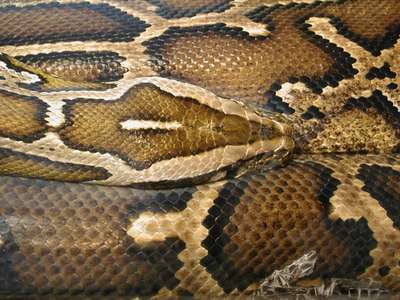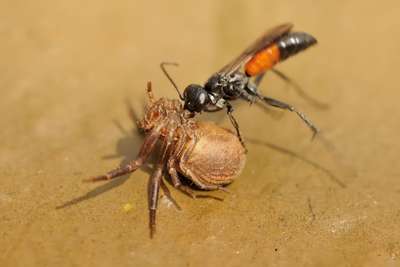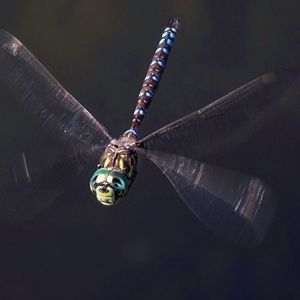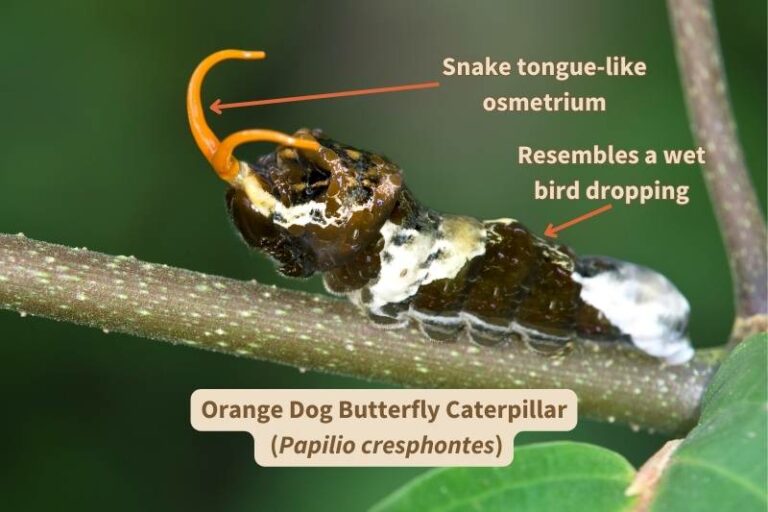Most of the world’s snake species are modestly sized and much smaller and lighter-weight than the average human. But some snakes are truly enormous and thus have become so famous that their names – python, boa constrictor, anaconda – are familiar to most people. But what are these snakes (besides gigantic)? Are they different species or the same snake going by different names?
Pythons, anacondas, and boa constrictors are the largest snake species in the world; while they are closely related and similar in many ways, they are classified in different families within class Reptilia, order Squamata. All are powerful, heavy-bodied snakes that kill their prey by constriction.
This post focuses on some of the largest species of snakes in the world and sorts out how they are similar, how they are different, and how they manage to thrive in a world where many other ancient animal species – large and small – are facing extinction.
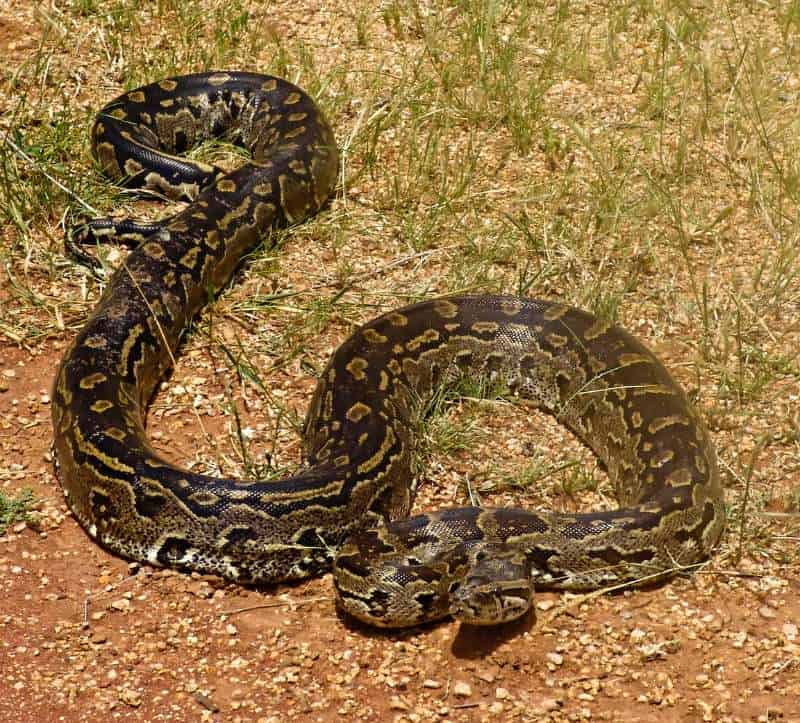
The big boys
The largest snakes in the world come from two families within class Reptilia, order Squamata: family Pythonidae and family Boidae.
Snakes classified within family Pythonidae are the “pythons” and includes the species generally acknowledged as the world’s longest snake, the reticulated python (Broghammerus reticulatus or Python reticulatus).
Native to the rain forests of southeast Asia, including India, Bangladesh, Thailand, Myanmar, Cambodia, Vietnam, and the Philippines, adult reticulated pythons can grow to between 4 feet 11 inches (1.5 m) and 21 feet 4 inches (6.5 m) and sometimes slither into houses and buildings looking for food, mates, and nesting sites.
To really appreciate the size and scale of these reptiles – and their disconcerting habit of slithering into buildings, check out this YouTube video of mating pythons:
Family Pythonidae contains 39 additional species; seven of which are also found in Asia, 4 in Africa, and 28 in Papua New Guinea and Australia (Halliday and Adler 2015). Other well-known pythons include the Burmese python (Python molurus bivittatus), Northern African python (Python sebae), and ball python (Python regius).
Snakes classified within family Boidae are the “boas” and includes the species recognized as the world’s heaviest snake, the green anaconda (Eunectes murinus).
Native to the Amazon rainforest and found throughout South America east of the Andes, female adult green anacondas can weigh up to 176 pounds (80 kg) (Wikipedia 2023); males are smaller and lighter. They are slightly shorter in length but thicker in diameter compared to reticulated pythons, so can weigh almost half again as much. Green anacondas live primarily along rivers and in swampy areas with lots of water and heavy vegetation so are less common around human habitations.
Family Boidae contains 57 additional species found in North and South America, Africa, Madagascar, Europe, and the Pacific region. Probably the most familiar species is the boa constrictor (Boa constrictor constrictor) but snakes such as the emerald tree boa (Corallus caninus) and the rainbow boas classified within genus Epicrates are also well-known.
General appearance
Most pythons and boas look similar at first glance. They are usually thick-bodied, heavy, stocky snakes with triangular heads which are distinct from their bodies, and smooth, unkeeled scales. Their scales are often patterned in muted patterns or blotches that can be used for species identification but which can also change color depending on an individual snake’s age, habitat, and dietary intake
Reticulated pythons vary widely in appearance with age, diet, and habitat but are generally covered with diamond-shaped blotches down the lengths of their bodies.
Green anacondas are olive to dark green and covered with black spots irregularly spaced along its body. Its head is slightly narrower and less defined from the body than those of the pythons and especially the boa constrictor and often has an orange-yellow stripe running along each side.
Burmese pythons have an arrow-shaped pattern on the tops of their heads and a central row of large, irregular dark brown blotches which runs the length of their bodies and sides. Their body color is usually golden brown on the sides and back and tan or cream on the belly. The centers of each blotch are a paler brown than the edges.
The base body color of boa constrictors is usually gray or tan on the back and sides, while their belly color is usually cream and gray; their tails are usually more reddish than the rest of their bodies. Dark brown saddles, sometimes with uneven white spots in the centers, run the length of the body and become more pronounced and reddish towards the tail. Their heads have three stripes; one runs from the snout over the top of the head to the neck, while one stripe on each side of the head runs from the snout to the eye and on to the neck.
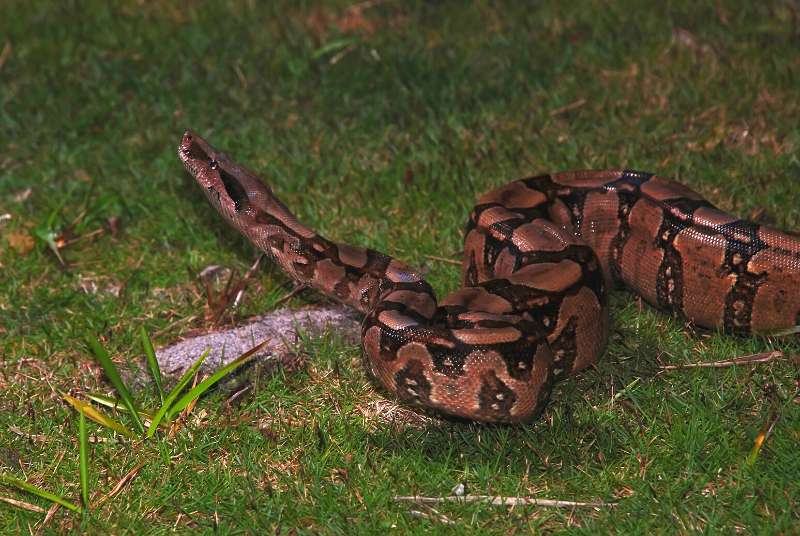
One important visual difference between these species of snakes is the presence or absence of pits on the upper lip,which sense infrared radiation (heat) and help the snakes zero in on potential food while hunting in the dark. Pythons and most boas have them, anacondas and boa constrictors don’t. While similar to the pits found in pit viper snakes (family Viperidae), pythons have several on each side of their mouths, while pit vipers have only one pit per side.
Boa constrictors still sense heat using the scales of their upper lips (Greene 1997); they just don’t have visible, external pits. Green anacondas do not sense infrared radiation while hunting, despite being classified in the same family as boa constrictors and other boids.
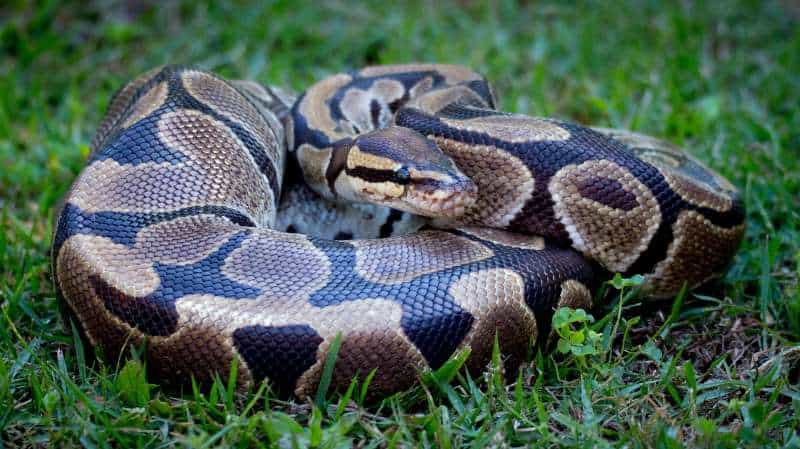
Hunting behaviors
All of these snakes are ambush hunters; they are too big and heavy-bodied to successfully chase prey down. Even though these snakes are very large, their blotchy coloration serves as superb camouflage while they lie in wait for prey to wander within striking distance.
As noted above, pythons and the boas rely in part on their ability to sense heat to find and successfully attack their prey and are land-based predators. Pythons often hunt from trees; they climb into a tree, dangle their heads down, and hang motionless until an animal gets close enough to strike. Boa constrictors may also hunt from trees but often locate prey burrows and lie in wait at the entrances. Again, their camouflage and ability to remain motionless for long periods of time makes it difficult for prey to notice the snakes.
Green anacondas are the odd-man-out among these species in that they are water-based predators. They evolved several adaptations that make them superb aquatic ambush hunters. They live in swampy conditions or in rivers; the water in these areas tends to be murky with limited visibility beyond the first few inches of depth. The anaconda’s body coloration blends perfectly into the water; it may be hard to believe but these enormous snakes can essentially disappear in just several inches of water.
Additionally, green anacondas’ eyes and nostrils are located on the top of their heads, rather than on the sides and front of the snout respectively as in pythons and boa constrictors. This anatomical positioning is similar to that of their fellow water-hunting reptile relatives, the alligators, and allows them to see and breathe while their large bodies are hidden beneath the water surface.
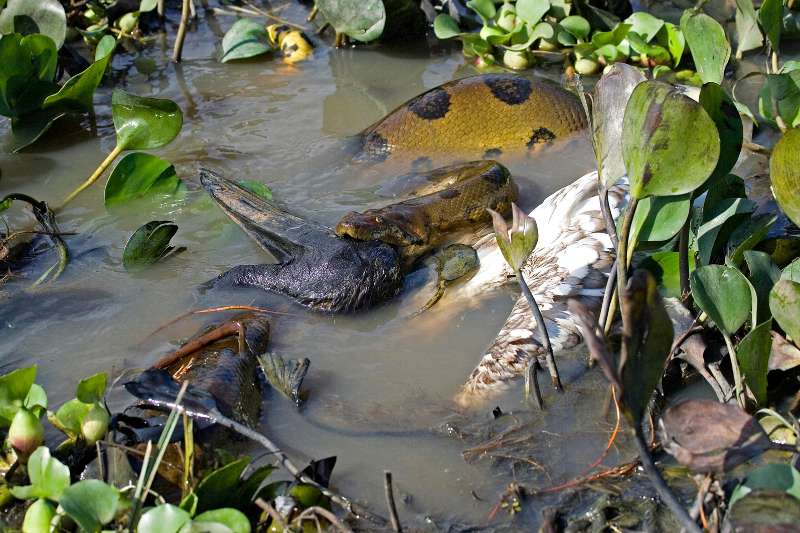
Regardless of how each species of snake encounters its prey, all kill in the same way – by constriction. Unlike some of the faster-moving, more slender snake species, pythons, boa constrictors, and anacondas leverage the incredible strength of their bulky bodies and the natural flexibility of the snake spine to kill their prey.
These snakes coil their bodies around their prey and squeeze to suffocate their prey. Muscles in constricting snakes like these cross fewer vertebrae than do those in non-constricting snakes which lets pythons and boas generate enormous force (Lillywhite and Harvey 2014). They tighten their coils every time they sense the prey exhale. The prey’s respiratory muscles are never stronger than the snakes’ constricting muscles so they are unable to inhale and suffocate quickly.
In addition to constriction, green anacondas have another extremely effective means of killing their prey. Because they hunt along the water’s edge, these snakes can drag prey underwater and drown them.
Pythons and boas have teeth but they don’t kill directly with them. Instead, their teeth help them swallow prey whole; the design of their teeth is so effective for this purpose that once an animal is pierced by the snake’s teeth, even the snake can’t release it.
Reproduction
Perhaps the biggest difference between pythons and boas is how they reproduce. Pythons are oviparous, or egg-bearers, while boid snakes bear live young. Female Burmese pythons can lay up to 107 eggs at a time, although 25 – 50 is more typical, while female boa constrictors give birth to a maximum of 60 live young (Simberloff and Rejmanek 2011).
Pythons are noteworthy in that they both guard their eggs and actively protect them from dangerously cold temperatures. Some – but not all – species of pythons, including the Burmese python and the reticulated python – rapidly contract and relax their muscles when they sense their eggs are getting too cold. This behavior is called “shivering thermogenesis” and is remarkable because it essentially makes these naturally ectothermic animals “warm-blooded”, even if only temporarily.
(For more information about ectothermy in reptiles, check out this other Now I Wonder post “Can reptiles get too cold?“).
Shivering thermogenesis is an effective technique that maximizes the clutch’s viability and thus the survival of the snakes’ genetic material but requires a lot of extra energy from the females. Depending on environmental temperatures, female pythons may lose up to 15% of their body mass incubating their eggs because they use up so much energy shivering (Greene 1997).
Conclusion
Most of the species classified within both the python and boa families are small to medium sized; the majority of boid snakes are less than 79 inches (2 meters) in length and the smallest python species is the anthill python (Antaresia perthensis) which grows to only 12 inches (30 cm). However, the reticulated python, Burmese python, boa constrictor, and green anaconda are the exceptions to this rule. In fact, these constrictors are exceptional in every way; exceptionally large, exceptionally strong, and exceptionally successful as some of the top ambush predators in the world for more than 47 million years.
Related Now I Wonder Posts
To learn more about snakes, check out these other Now I Wonder posts:
- Can snakes swim?
- Can you tell a snake is venomous by the shape of its head?
- Cottonmouths vs. water moccasins: What you need to know
- Do snakes eat other snakes?
- How do snakes move around?
- Can snakes climb trees?
- Why do snakes climb trees?
- What are the world’s biggest snakes afraid of?
References
“Boas and Pythons: Families Boidae, Pythonidae.” In Firefly Encyclopedia of Reptiles and Amphibians, by Tim Halliday, and Kraig Adler. 3rd ed. Windmill Books (Andromeda International), 2015.
Greene H W. 1997. Snakes: The Evolution of Mystery in Nature. Berkeley and Los Angeles: University of California Press, LTD.
Lillywhite H B. 2014. How Snakes Work: Structure, Function, and Behavior of the World’s Snakes. Cary: Oxford University Press.
Simberloff D, Rejmanek, M. eds. 2011. Encyclopedia of Biological Invasions. Berkeley: University of California Press.
Wikipedia. 2023. Green anaconda. [Internet]. Available at: https://en.wikipedia.org/wiki/Green_anaconda

